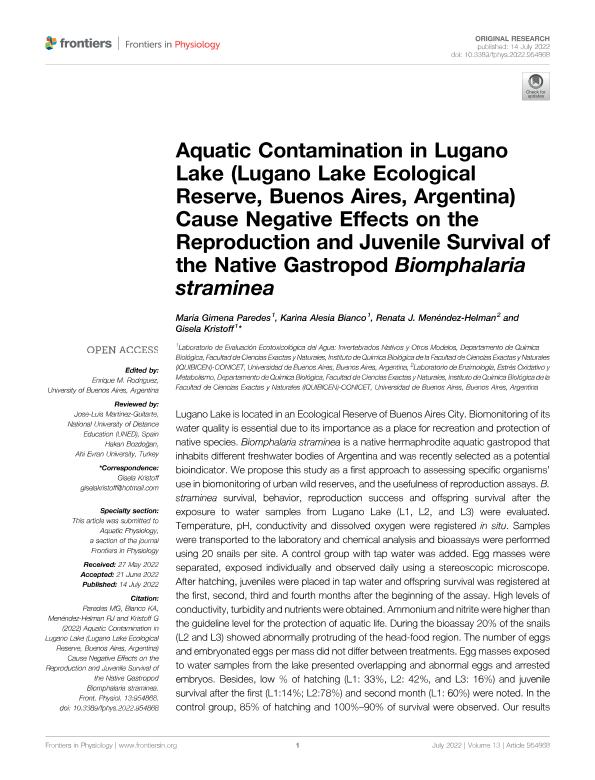Artículo
Aquatic Contamination in Lugano Lake (Lugano Lake Ecological Reserve, Buenos Aires, Argentina) Cause Negative Effects on the Reproduction and Juvenile Survival of the Native Gastropod Biomphalaria straminea
Fecha de publicación:
07/2022
Editorial:
Frontiers Media
Revista:
Frontiers in Physiology
ISSN:
1664-042X
Idioma:
Inglés
Tipo de recurso:
Artículo publicado
Clasificación temática:
Resumen
Lugano Lake is located in an Ecological Reserve of Buenos Aires City. Biomonitoring of its water quality is essential due to its importance as a place for recreation and protection of native species. Biomphalaria straminea is a native hermaphrodite aquatic gastropod that inhabits different freshwater bodies of Argentina and was recently selected as a potential bioindicator. We propose this study as a first approach to assessing specific organisms’ use in biomonitoring of urban wild reserves, and the usefulness of reproduction assays. B. straminea survival, behavior, reproduction success and offspring survival after the exposure to water samples from Lugano Lake (L1, L2, and L3) were evaluated. Temperature, pH, conductivity and dissolved oxygen were registered in situ. Samples were transported to the laboratory and chemical analysis and bioassays were performed using 20 snails per site. A control group with tap water was added. Egg masses were separated, exposed individually and observed daily using a stereoscopic microscope. After hatching, juveniles were placed in tap water and offspring survival was registered at the first, second, third and fourth months after the beginning of the assay. High levels of conductivity, turbidity and nutrients were obtained. Ammonium and nitrite were higher than the guideline level for the protection of aquatic life. During the bioassay 20% of the snails (L2 and L3) showed abnormally protruding of the head-food region. The number of eggs and embryonated eggs per mass did not differ between treatments. Egg masses exposed to water samples from the lake presented overlapping and abnormal eggs and arrested embryos. Besides, low % of hatching (L1: 33%, L2: 42%, and L3: 16%) and juvenile survival after the first (L1:14%; L2:78%) and second month (L1: 60%) were noted. In the control group, 85% of hatching and 100%–90% of survival were observed. Our results suggests the presence of pollutant in the lake. B. straminea seems to be a sensitive local species. Biomphalaria spp. reproduction assays can provide a valuable endpoint for toxicity and risk assessments and a usefulness tool for biomonitoring water quality.
Archivos asociados
Licencia
Identificadores
Colecciones
Articulos(IQUIBICEN)
Articulos de INSTITUTO DE QUIMICA BIOLOGICA DE LA FACULTAD DE CS. EXACTAS Y NATURALES
Articulos de INSTITUTO DE QUIMICA BIOLOGICA DE LA FACULTAD DE CS. EXACTAS Y NATURALES
Citación
Paredes, Maria Gimena; Bianco, Karina; Menendez Helman, Renata Julia; Kristoff, Gisela; Aquatic Contamination in Lugano Lake (Lugano Lake Ecological Reserve, Buenos Aires, Argentina) Cause Negative Effects on the Reproduction and Juvenile Survival of the Native Gastropod Biomphalaria straminea; Frontiers Media; Frontiers in Physiology; 13; 7-2022; 1-11
Compartir
Altmétricas




